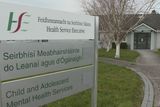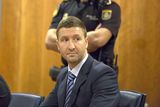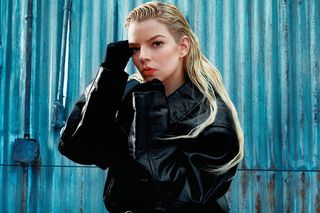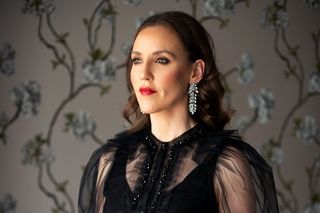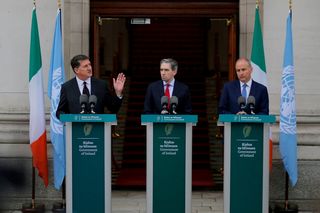Rocky Road to Dublin: the film that revisits the old Ireland we tried so hard to escape
The documentary, which was never distributed here, is a poignant reminder of life in the 1960s where Irish women were seen but not heard
Rocky Road To Dublin - Film Trailer
In the midst of yet another referendum campaign, we are wondering about what kind of Ireland we want, and how much of our past we should keep.
There is a film that looked at the same questions, and received little thanks for it. It would not be true to say that Rocky Road to Dublin, made in 1967, is in the news, exactly, but it is being discussed on a podcast.
Rocky Road to Dublin, a documentary just over an hour long, was not formally banned. Instead it was what Aoife Bhreatnach, presenter of the Censored podcast, calls “shadow banned”.
Rocky Road To Dublin is a beautiful, furious film. It tells the truth: that the rare oul’ times were pretty awful. And it shows that the people, although dancing and singing and watching sport and snogging (a bit), deserved better. Made shortly after the 50th anniversary of the Easter Rising, it asks an interesting question: “What do you do with your revolution when you’ve got it?”
One old revolutionary, Seán Ó Faoláin, who fought in the War of Independence, is not impressed with the Ireland of 1967. In the film he calls it “a society without moral courage, observing a self-interested silence, never speaking in moments of crisis. The whole spirit of ’16 has been lost.”
That was never going to go down well. The film was not distributed in Ireland.
Its director, Dubliner and Guardian journalist Peter Lennon, went back to his new home in France, at that time just about to experience the riots of May 1968. It was in that same month that Rocky Road To Dublin was shown at the Cannes Film Festival, as one of the few films on the Critics’ Choice list. . Godard and Truffaut stood up after the Cannes screening to say that they wanted the festival cancelled so that everyone could concentrate on the riots in Paris.
Read more
Lennon had employed the best film cameraman in France, Raoul Coutard, who took a break from working with Godard and Truffaut to work on the Irish film, who shot informally, with a handheld camera, as was the style of the New Wave, the punk version of cinema, which had exploded in France.. Lennon’s work in Paris for the Guardian newspaper had allowed him to befriend intellectuals. He was a friend of Samuel Beckett.
Peter Lennon had grown up in Dublin. His family was newly impoverished and moved around the city, renting for a time in Leinster Road in Rathmines. He attended the Christian Brothers’ school in Synge Street.
And it was to Synge Street that Lennon brought Raoul Coutard and their film crew, to record little boys reciting the catechism; at one point a prepubescent boy recites all the dangers to chastity. It is a scarifying list.
Raoul Coutard was particularly good at filming children, whether in the classroom or playing in the rubble of Dublin’s many slums. He was also very good at shooting Dublin crowds, and the priests and nuns who moved among them: at the Horse Show, at a GAA match in Croke Park. It is easy to forget just how many priests and nuns we had at that time.
Father Michael Cleary is interviewed. Time would prove how prescient Lennon was in choosing this example of what was then a modern priest: Cleary lectured on sex and restraint even though he fathered two children.
All the women shown on camera in Rocky Road to Dublin are silent: little girls walking to the shops, young women in dance halls, young women in pubs listening to the men sing and play. Even the lone woman at a discussion by Trinity College students — and filmed, like much of the socialising here, in a pub — does not get a word in, although she tries. The only female voice comes off camera, from a young wife describing her attempts at using so-called natural methods of contraception.
This is a view of the new patriarchy, which looks just like the old patriarchy.
But the besuited men interviewed are offset by Coutard’s shots of street life, showing the vitality of the people, and a lot of smoking.
In France the rioting students screened the film at the Sorbonne. In Ireland it only escaped being banned because, as the censor explained to Peter Lennon, there was no sex in it. Its showing at the Cork Film Festival was timed to coincide with a boozy lunch for journalists which took place 20 miles away. It was shown in one Dublin cinema — and then nothing, for 25 years.
You can watch Rocky Road To Dublin on YouTube. Or you can rent it online from the Irish Film Institute for €4.50. If you take the IFI option, you can see a fascinating companion film, The Making of Rocky Road To Dublin, directed by Paul Duane, in which a much older Peter Lennon looks back on how he created it, and chats to Raoul Coutard.
On Censored, Aoife Bhreatnach and her co-presenter Lloyd Meadhbh Houston laughed at the Anglicised accents of the experts and criticised the film for not covering the North or the Magdalene laundries. But Lennon said the film was affectionate, always on the side of the people, and personal to him. It is, as he pointed out, the only Irish film record of Ireland in the 1960s.
Join the Irish Independent WhatsApp channel
Stay up to date with all the latest news




